 Twin Stream
Twin Stream
due to limitations of most web-browsers, you may have trouble printing this document with readable topos. If this is the case, you can click here to download a MS Word97 version (~700KB) of this guide, which will print correctly from Word97, or from MS's freeWord97 viewer
Twin Stream in the Ben Ohau Range crosses the Twizel to Mount Cook road just
before the Glentanner Station and airport, permission to cross the Glentanner
Station land should be obtained from Ross Ivey Ph 03 435 1843.
The best way
in is by helicopter from Glentanner Park (Helicopter Line, Ph 03 435 1855 or
0800 650 651). The walk in takes 2 to 3 hours and starts on the true R, follow the
river bed from the bridge for 500m past the first hill and climb up to a farm track.
Cross the side stream and climb the clearest spur to the upper terrace moving
5m right at the top and up a shallow gully to where an old bulldozer track leads around the edge
of the terrace. Where this ends continue along the terrace edge to a dry
stream at the midway shingle flats. Either follow the true R of the upper
gorge or hop the stream to find the easiest travel to the upper basin. The
Central Buttress is directly above the grassy landing site and camp-site,
Southerly Front Slab is out of sight further up the scree slopes to the L.
Shindig Gully is visible from the tombstone like boulder across the stream.
Shelter
There are three small rock bivies, one at the top of the grassy flat and two under isolated boulders in the scree-field below southerly front (both have water nearby). For larger groups it is worth taking tents, but the upper valley has little protection from a good nor-wester.
Half Moon Slab
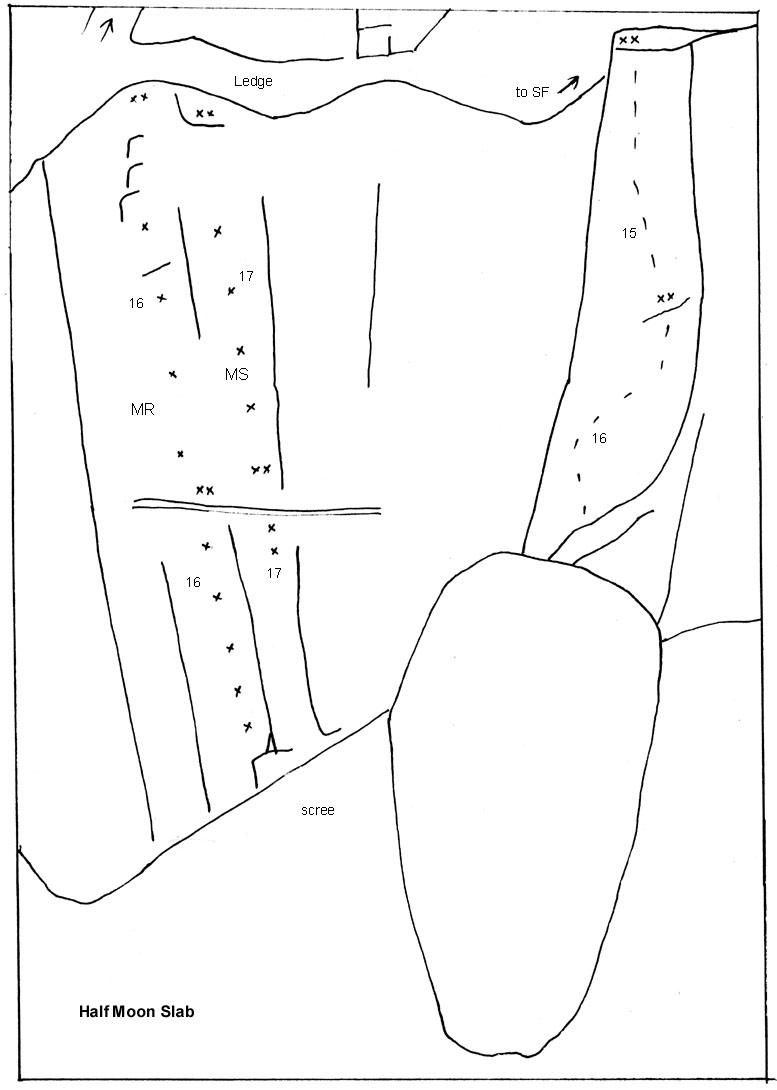
| Moon Rise | 17,17 | Murray Judge, Al Mark April 1997. |  |
| Moon Struck | 16,19 | Dave Brash, Muray Judge Oct 1996, April 1997. |  |
Hugh Logan climbed a line on this slab in 1976 and the buttress above.
| Moonshine Buttress | 16,14 | Murray Judge, Jonathan and Matt, Jan 1997 |  |
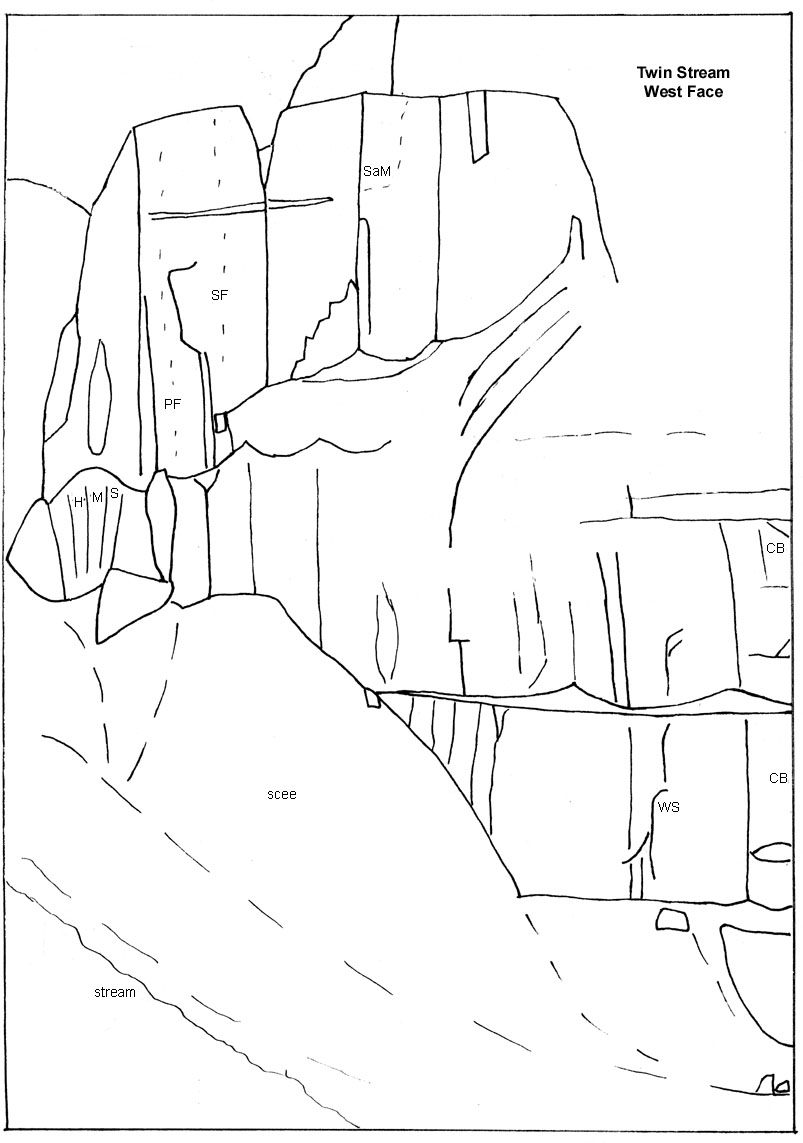
Southerly Front Slab
This impressive feature of tilted greywacke is separated from the main wall at the top and is free of stone-fall danger except in the white corner and around the scree gully at its base.The climbs can be approached by climbing a two pitch route on the lower Half-Moon Slab or via an easy gully up past the Half-Moon Slab.
Hugh Logan, with Paul Scaife climbed a line on the outer aspect of the buttress, reaching the L edge of the slab after two or three pitches and traversing along the top of the slab with a short abseil to reach the main wall, Hugh later climbed a different start with John Hobison in 1977 up a chimney with a huge chockstone, on the right of the first line and joining it after three pitches. On both climbs they continued up and descended the gully now known as Shindig Gully.
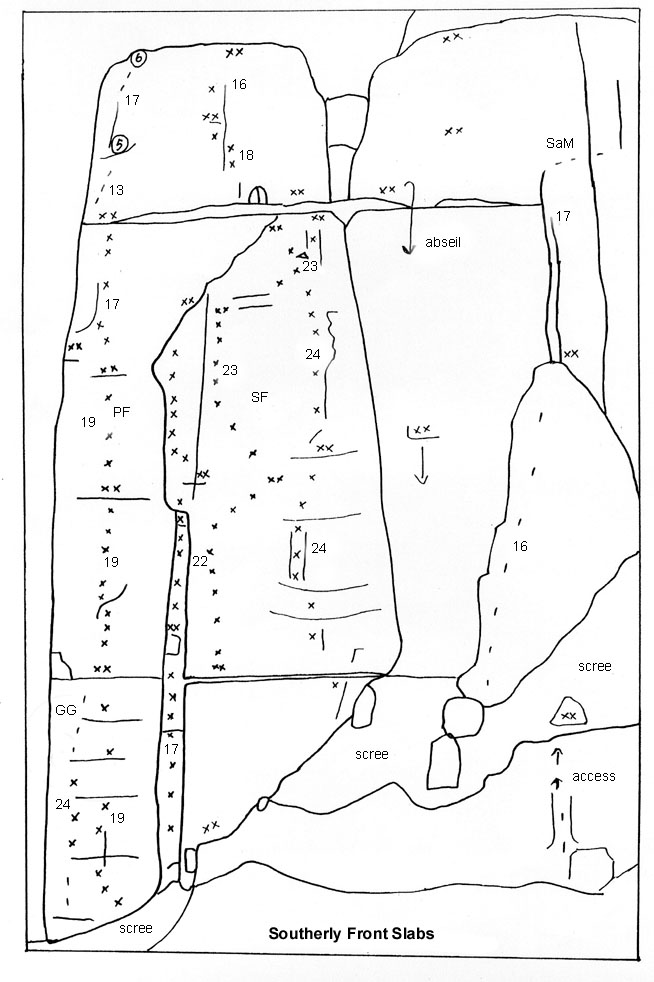
| Gomers Go Round | 18,17,17 | Al Mark and Murray Judge April 1997 |  |
climbed to gain access
| Gomers go to Ground | 24 | Al Mark April 1997 |  |
Three bolts and a little natural pro, some very fine slab climbing.
| Pulp Friction | 21,22,21,?? | Al Mark, Murray Judge April 1997 |  |
Four pitches so far, up the centre of the L hand slab.
| Ground Hog Day | 17,19,20 | Tony Pine, Murray Judge Jan 1999 |  |
Climb pitch one of Southerly Front to the traverse and continue up the shallow pillar to belay on a flake. Climb the pillar to the roof and a quick pull onto the upper slab and up to belay ledge, traverse left across the slab and up the left hand edge.
| Southerly Front | 17,20,23,23,18,15 | Murray Judge, Andrew Mcfarlane, Robyn Thompson Feb 1996 |  |
Start below the large chockstone, climb the shallow pillar to a horizontal break and traverse L to the belay. Three pitches up the R hand slab to the ledge below the headwall. The two headwall pitches were climbers by Murray Judge, Andrew McFarlane and Tony Pine in Feb 1998.
| Sticky Date Pudding | 24,24 | Al Mark, Geoff Ellis Jan 1998 |  |
two long pitches to the right of Southerly Front
| Rock Vandals | 20,22,14,16 | Tony Pine, Murray Judge, Andrew McFarlane Feb 1998 |  |
two pitches on the right of the white corner. Above the ledge, climb the upper wall on natural gear to bolt belays.
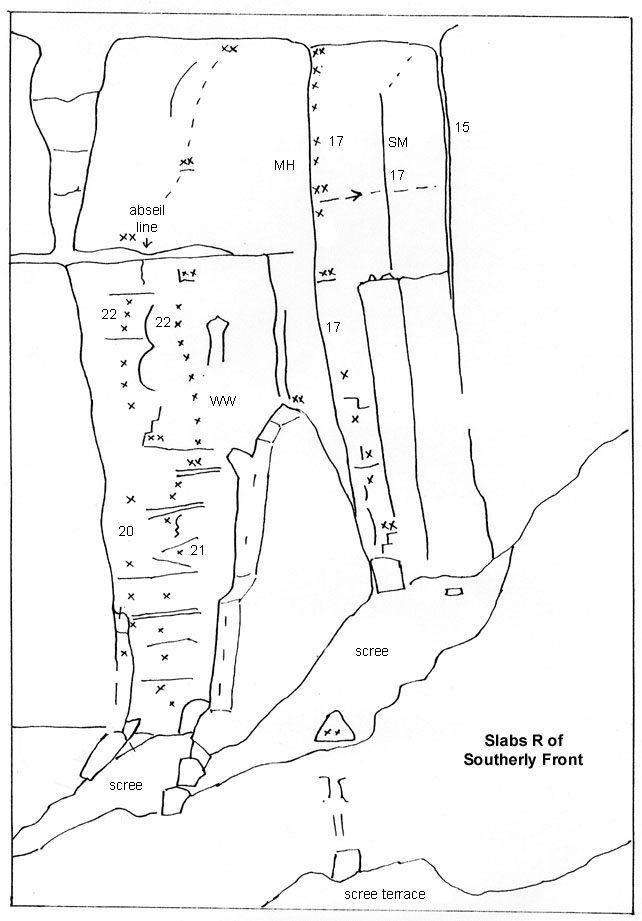
| The Western World | 21,22 | Andrew McFarlane, Grant Piper Feb 1998 |  |
| March Hare | 17,18,18 | Murray Judge, Tony Pine, Hayden McKay Jan 1998 |  |
three excellent pitches up the arete
| Stealing a March | 16, 17, 17 | John McCartney, Andrew Mcfarlane Dec 1995 |  |
From the scree climb a broken rock pillar (the right hand of the three pillars) to the base of Southrly Front slabs. The broken rib leads to a groove L of the arete, higher up traverse R around the arete to a thin crack on the upper wall. The wide crack and chimney line on the far right of the upper wall was climbed by Murray Judge and Tony Pine in Jan 1998
The Lower Wall
The Central Buttress and the walls to its left and right are split at half height by a broad terrace which can be gained from the scree at its left end. Just down from this point are some narrow inset slabs:
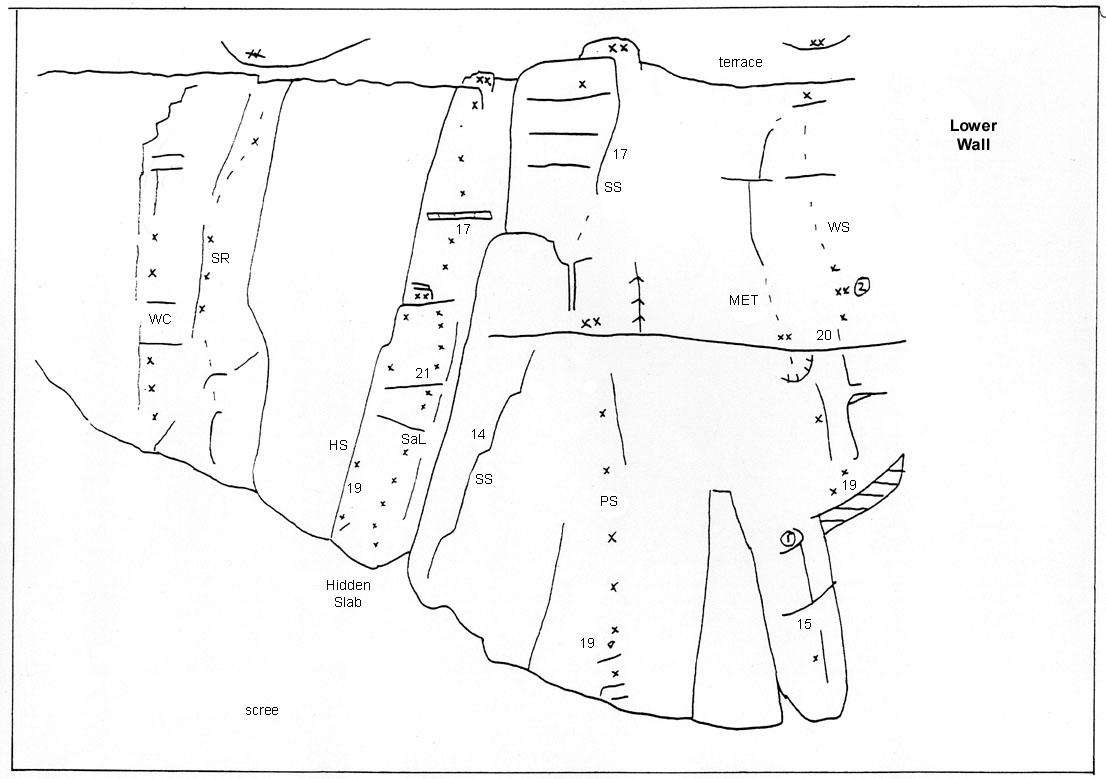
| Wild Coyote | 18 | Sam Brooks, Murray Judge March 1998 |  |
| Spare Rib | 19 | Murray Judge, Toby Judge Nov 1997 |  |
| Hidden Slab | 19,17 | Murray Judge, Andrew Mcfarlane Jan 1997 |  |
| Secrets and Lies | 21 | Murray Judge, Al Mark April 1997 |  |
| Stoney Showers | 14, 17 | Tony Pine, Jonathan Clearwater Nov 1997 |  |
right slanting grooves to the right of Hidden Slab
| Peanut Slab | 19 | Murray Judge, Sam Brooks, Jonathan Clearwater Nov 1997 |  |
| Wily Spaniard | 15, 20, 16 | Murray Judge, Sam Brooks Nov 1997 |  |
a three pitch climb with varied and intricate climbing.
The Central Buttress

| Once Were Wasters | 17,21, 21 | Alistair Mark, Geoff Ellis Jan 1998 |  |
start below the roof on a left slanting slab, above the first belay move right and up the corner and further right on the face holds to the thin crack line. At the terrace walk left for 30m to the start of the upper wall. Pitch 3 Murray Judge, Sam Brooks March 1998.
The thin crack up to the large roof was aided by Tony Pine and Murray Judge in 1998, later free climbed at grade 24 by Steve Monks Jan 1999.
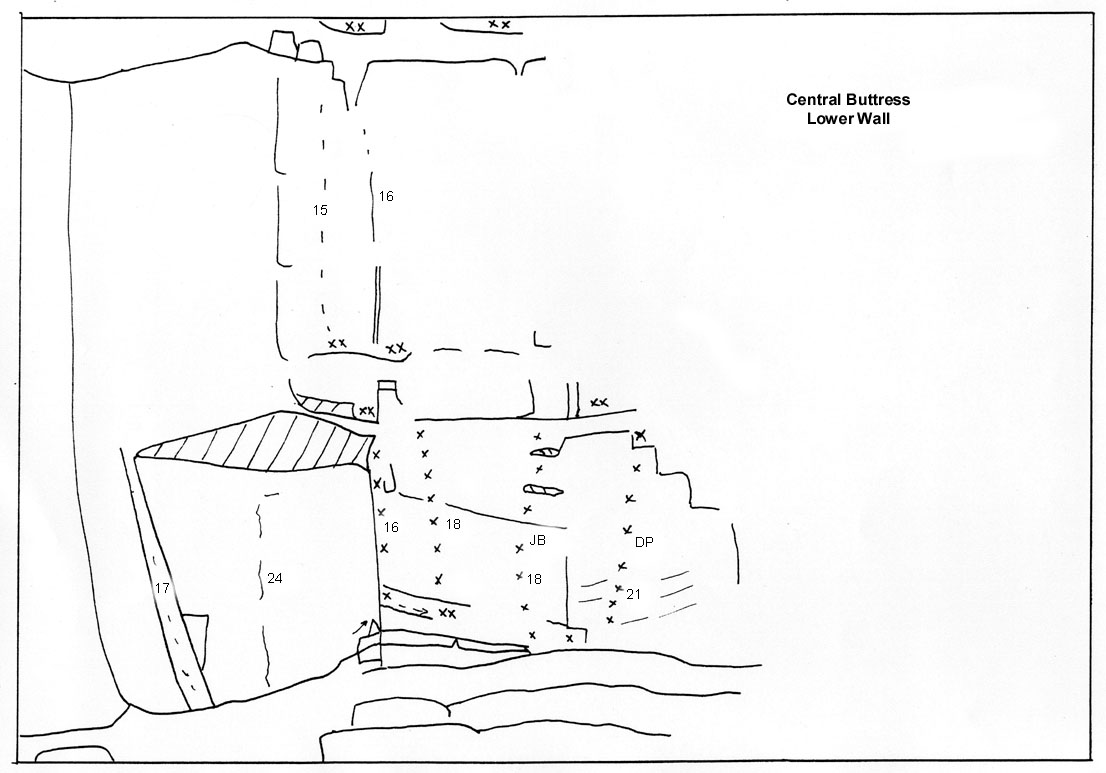
| El Nino | 16,14,15 | Tony Pine, Sam Brooks, Jonathan Clearwater Nov 1995 |  |
The Central Buttress arete, a long third pitch up to the terrace.
| Central Buttress | 18,16 | Bronwyn Judge, Murray Judge April 1997 |  |
slab and wide cracks. The large roof breaks the lower third of the buttress, at the base of the wall traverse L around the arete and across to a belay. Climb the slab to the alcove and through the overlap to a sloping ledge. The wide crack narrows to a pleasant hand crack through the bulge.
Slabs to right of Central Buttress
| Jumbo Burger | 18 | Andrew McFarlane Jan 1998 |  |
| Dial a Pizza | 21 | Murray Judge Jan 1998 |  |
Upper Wall
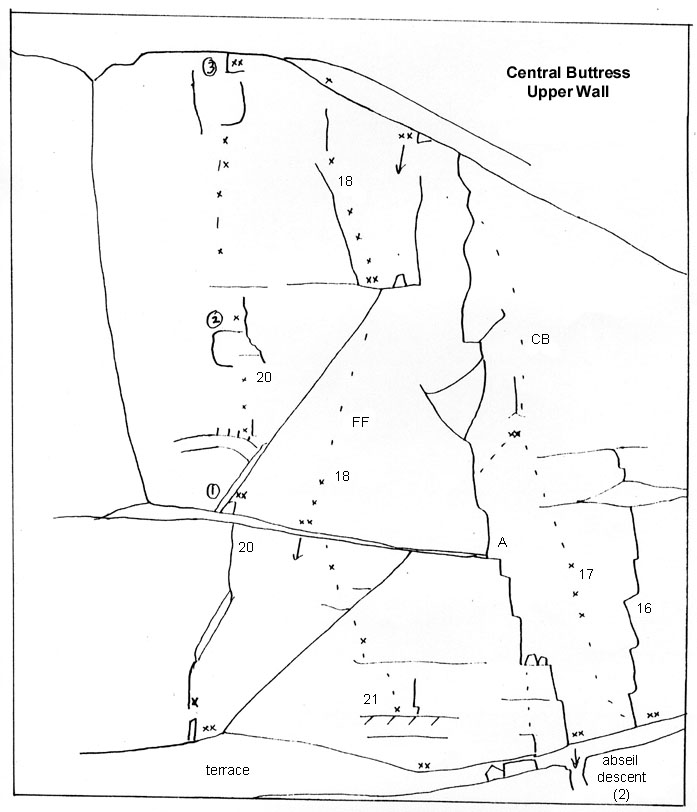
| Feathered Friends | 21, 18, 18 | Murray Judge, Tony Pine April 1997 |  |
Pull through the overlap and onto the wall, some fine flaky climbing. The upper pitches are steep and juggy.
| El Nino: The Arete | 12, 15 | Murray Judge, Sam Brooks, Tony Pine April 1997 |  |
Start on L side of the arete off the terrace, climb some short walls and move around to the right of the arete near the end of the pitch to find the belay. Climb up and left to the top of the arete.
| Central Buttress (Pitches 4) | 17 | Murray Judge, Sam Brooks, Tony Pine April 1997 |  |
Takes the slabs right of the arete.
| Marigold | 16 | Bronwyn Judge, Murray Judge April 1997 |  |
The stepped line of flakes.
Slabs right of steep south wall
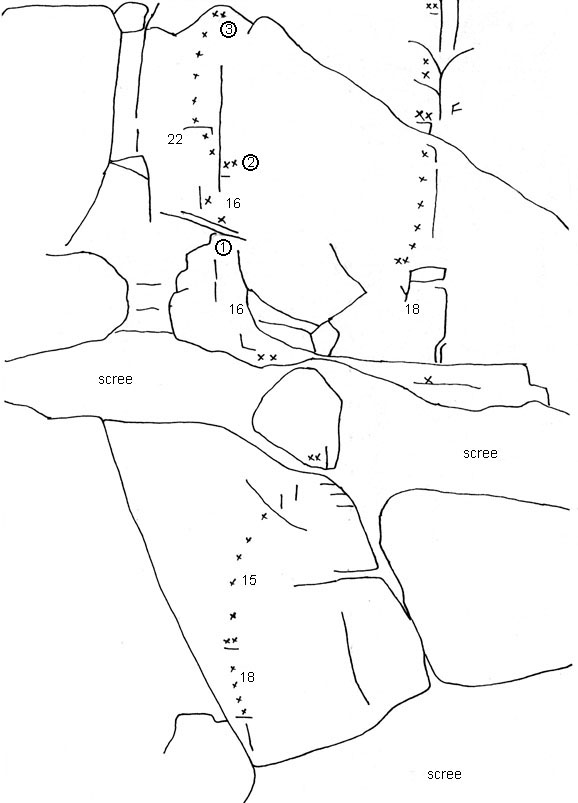
| Siberia | 18,15,16,16,22 | Murray Judge, Andrew McFarlane Jan 1998 |  |
two pitches on the lower slabs to the ledge, move up and left around the overhangs to a natural belay below the overlap.
The Fin
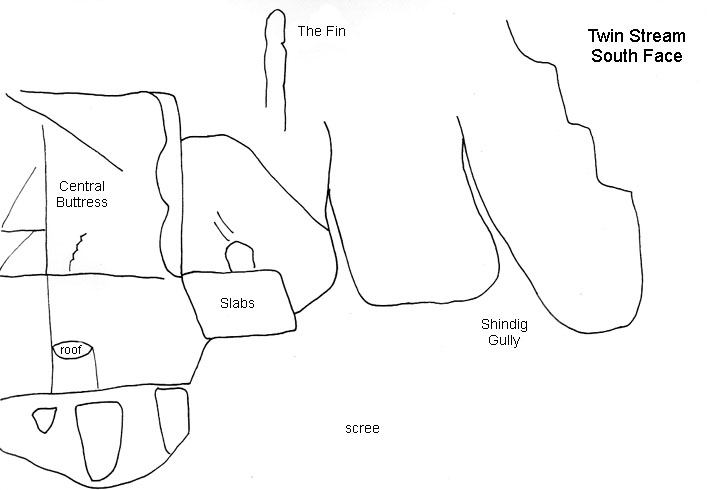

The fin is a knife-like blade of rock seen from the top of the upper gorge.
The route can be started off the slabby terrace accessible from the gully L of Shindig Gully. (Look for a ring bolt at top of the terrace).
| The Fin | 18,16,15,16,21 | Andrew Mcfarlane, Murray Judge Jan 1997 |  |
Gully Left of Shindig Gully
This was climbed by Hugh Logan and Darryll Thompson in 1977, six pitches on rotten rock, descending Shindig Gully.
Shindig Gully
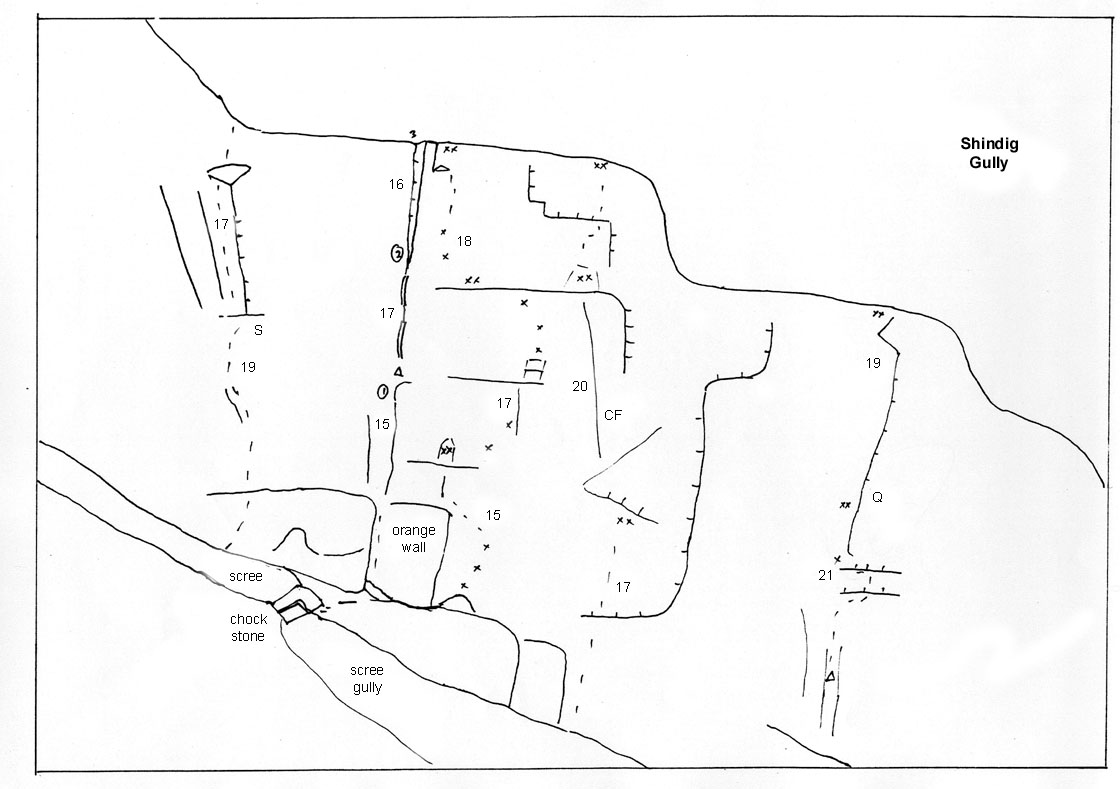
This is the largest and most downstream of the gullies with a sheer left wall extending up the gully. The gully itself is the best access route to the upper parts of the mountain, mostly scree with an occasional rock step, it was used as a descent route by Hugh Logan in the 1970s. There are presently three routes on the left wall.
| Steerpike | 19,17,19 | Bill Mcleod, Peter Dickson 1997 |  |
| Centre Fire | 17,20,20 | Bill McLeod, Peter Dickson Feb 1997 |  |
| Quake | 21,19 | Bill McLeod, Peter Dickson Feb 1997 |  |